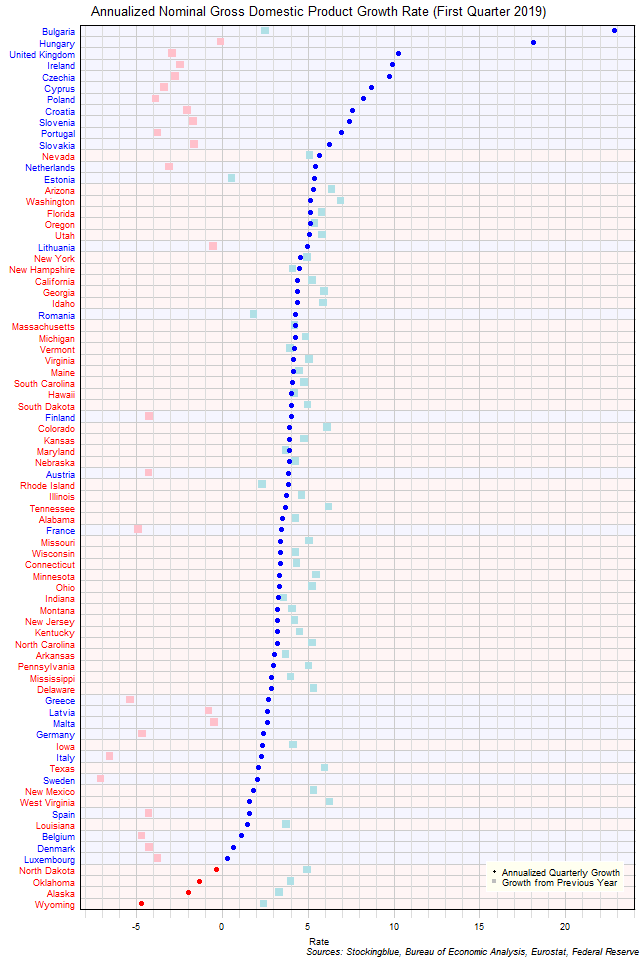
The chart above shows the annualized nominal gross domestic product (GDP) quarterly growth rate when the GDP is priced in US dollars in each EU and US state as of the first quarter of 2019 and the growth rate from one year prior. All negative quarterly growth rates are in US states whereas all negative year-over-year growth rates are in EU states.
Findings
- The difference between the state with the largest annualized quarterly growth rate, Bulgaria, and the state with the smallest, Wyoming, is 27.56 percentage points.
- The difference between the state with the largest year-over-year growth rate, Washington, and the state with the smallest, Sweden, is 13.96 percentage points.
- The median annualized quarterly growth rate in the 28 EU states is 4.62% and the mean 5.91%. The median year-over-year growth rate in the 28 EU states is -3.24% and the mean -2.80%.
- The median annualized quarterly growth rate in the 50 US states is 3.72% and the mean 3.26%. The median year-over-year growth rate in the 50 US states is 4.83% and the mean 4.78%.
- The median annualized quarterly growth rate in the 78 EU and US states is 3.88% and the mean 4.21%. The median year-over-year growth rate in the 78 EU and US states is 4.11% and the mean 2.06%.
- Thirty-four states' economies grew faster over the previous quarter than they did over the same quarter last year (28 from the EU, 6 from the US). The remaining 44 states saw their economies grow slower over the previous quarter than they did over the same quarter last year (0 EU, 44 US).
- All EU drops in GDP growth rate are attributed to currency rate fluctuations.
Caveats
- Data is from the first quarter of 2019, the fourth quarter of 2018, and the first quarter of 2018.
- The data is seasonally and calendar adjusted in current dollars except for Slovakia which is only seasonally adjusted in current dollars.
- Euros are converted to dollars at an average exchange rate of 1.14 for the first quarter of 2019, 1.14 for the fourth quarter of 2018, and 1.23 for the first quarter of 2018 according to historic rates listed at the Federal Reserve (see source link below).
- US data comes in an annualized format which the EU does not, thus EU data is annualized by multiplying the quarterly figure by four.
- US growth rates may differ from those provided by the Bureau of Economic Analysis as the BEA's growth rates are based on chained dollars in conjunction with the chain index or the quality index for real GDP. The growth rates listed here are based on nominal GDP.
- All figures are rounded to the nearest hundredth.
Details
Wyoming had the largest decline over the previous quarter with an annualized drop of 4.72%. Bulgaria had the largest growth with an annualized gain of 22.84%.
Year over year, Sweden had the largest decline with a 7.06% drop in GDP while Washington had the largest growth with a 6.90% rise in GDP.
Wyoming saw the largest decrease in its growth rate between its year-over-year growth and its annualized quarterly growth slowing its rate by 7.14 percentage points. Bulgaria had the largest increase in its growth rate between its year-over-year growth and its annualized quarterly growth ramping up its rate by 20.33 percentage points.
Poland went from having the 68th largest growth rate over the same quarter last year to the 7th largest growth rate over the previous quarter. Conversely, West Virginia went from having the 3rd highest growth rate over the same quarter last year to the 69th highest growth rate over the previous quarter. No states had growth rates in the top ten both over the same quarter last year and over the previous quarter. Three states had growth rates in the bottom ten both over the same quarter last year and over the previous quarter: Spain (71st highest year-over-year, 70th highest quarterly), Belgium (74th highest year-over-year, 72nd highest quarterly), and Denmark (70th highest year-over-year, 73rd highest quarterly).
Sources
Eurostat. 2019. "GDP and Main Components." Accessed August 19, 2019. https://appsso.eurostat.ec.europa.eu/nui/show.do?query=BOOKMARK_DS-406779_QID_-64A128D_UID_-3F171EB0&layout=TIME,C,X,0;GEO,L,Y,0;UNIT,L,Z,0;S_ADJ,L,Z,1;NA_ITEM,L,Z,2;INDICATORS,C,Z,3;&zSelection=DS-406779UNIT,CP_MEUR;DS-406779INDICATORS,OBS_FLAG;DS-406779S_ADJ,SCA;DS-406779NA_ITEM,B1GQ;&rankName1=UNIT_1_2_-1_2&rankName2=INDICATORS_1_2_-1_2&rankName3=NA-ITEM_1_2_-1_2&rankName4=S-ADJ_1_2_-1_2&rankName5=TIME_1_0_0_0&rankName6=GEO_1_2_0_1&sortC=ASC_-1_FIRST&rStp=&cStp=&rDCh=&cDCh=&rDM=true&cDM=true&footnes=false&empty=false&wai=false&time_mode=NONE&time_most_recent=false&lang=EN&cfo=%23%23%23%2C%23%23%23.%23%23%23.
Federal Reserve. 2019. "Foreign Exchange Rates." Accessed August 20, 2019. https://www.federalreserve.gov/releases/g5/.
US Bureau of Economic Analysis. 2019. "GDP by State." Accessed August 18, 2019. https://www.bea.gov/data/gdp/gdp-state.